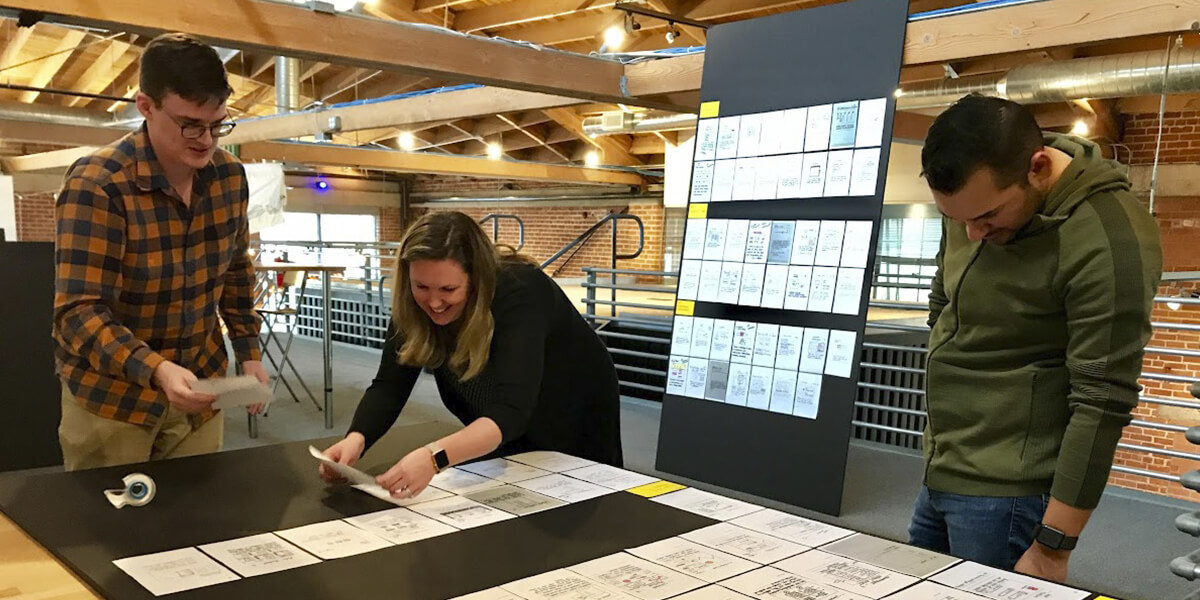
If you want to design the best experience for your users, you need to know their stories. Here at Blink, we recently wrapped up a project that demonstrated how the “qualitative story” of user research and the “quantitative story” of SEO and analytics can be paired to produce powerful insights that provide the evidence you need to craft the right experience.
We were thrilled with the way our typical user research process was bolstered with analytics-driven insights, and our search marketing partner found deep value and empathy in the personal perspectives offered by our one-on-one research sessions with users.
Like any good love story, someone made the first move. As part of the initial stage of a large medical website redesign, Blink was brought in (asked out?) by local search marketing firm Wheelhouse Search to lead the user research and information architecture efforts.
Blink and Wheelhouse worked as partners on parallel workstreams, with Blink performing qualitative user research while Wheelhouse analyzed user flows, keyword research, and other quantitative data from site analytics. Continuing the dance of qualitative and quantitative, Blink also completed a content audit of the current working site while Wheelhouse performed a content gap analysis with the client’s competitors.

We found that this partnership offered enormous value to the client. Search marketing insights from the Wheelhouse team paired exceptionally well with Blink’s research findings, providing a wealth of evidence that we could use to drive toward a user-centered information architecture for the new site. While protecting client specifics about the project, I have bubbled up a few of the key takeaways from this SEO/UX love story.
But first, what are SEO and UX?
Search engine optimization (SEO) refers to practices that increase your pages' search engine result page standing (SERP). Entities like Google use algorithms to filter through factors from your blogs, product pages, and other online content to determine which websites best answer a person's search query. Having a higher SEO rating can help customers better find your site and improve your standing with competitors.
User experience (UX) is how an existing or potential customer feels about interacting with your site and engaging with your brand. Several departments should consider UX, from research and development to marketing and sales, and use those insights to drive decisions about site design and content creation. Having a positive user experience can boost brand loyalty, customer retention, and SERP ranking.
How SEO and UX work together
Separately, SEO and UX research are both powerful tools your company and departments can leverage to interact with and engage your target audience. Both can influence each other, and understanding how they work together can strengthen your SEO and UX optimization practices. Here are my top three takeaways from our project with Wheelhouse:
1. Pairing SEO and analytic data with qualitative user research tells a more complete story
At Blink, we love how user research can uncover the big “whys” that we all want to know:
- “Why are they here?”
- “Why didn’t they click that?”
- “Why didn’t they see that?”
- “Why did they give up?”
User research is a powerful method for discovering intentions and behaviors. But there’s another story that often goes untold—one that user research sometimes can’t uncover. This is where SEO and analytics can provide a big, lovely N to bolster your one-on-one user research.
Looking at user data and analytics can show you, on a large scale, where users are popping in and jettisoning from your site, how users are journeying through your site (or if they aren’t), and how they got there in the first place (hint: keywords).
We all know that content is king; SEO and analytics can help you tailor your content to hit those sweet spots in search results. This all comes together to offer your users a better experience: If they can find you in the search results and find what they need on your site easily, you are going to be in good shape!
2. SEO + UX = client value
We love crafting great experiences for users, but we are also huge fans of giving our clients value through UX practices—the more insights that drive a product’s design, the better. To that end, by supplementing our normal user research process with insights from search marketing and analytics, we were able to offer the client even more powerful evidence of user behavior.
This was especially apparent in areas where our qualitative user research and the quantitative analytics pointed to the same user behavior—what a powerful way to show clients, “this is what your users are doing, and this is what they are looking for!” You can try to argue with what users are saying, or you can throw out questions about what your analytics are telling you, but when you combine these two sources of information, the evidence becomes really hard to argue with.
3. A designer's job is easier with insights and evidence
One of the largest benefits of the user-centered design process is the ability for design to be driven by evidence. While this offers an obvious advantage for business reasons, it can also provide a designer or information architect with confidence they might not have otherwise.

With insights and evidence from user research, a designer will find it much more straightforward to drive the work forward and defend it. Less uncertainty exists, which is almost always a good thing in the design process. And if I haven’t hammered this point home already, I will say it once more: user research is great and often gives us the evidence we need to solve our client’s design challenges.
Yet the addition of analytics and SEO-based evidence bolstered this process in a fantastic way, truly giving us all we needed to craft a user-centered structure for the client’s new site.
And that’s our love story. In the future, we look forward to finding new opportunities to pair search marketing and SEO with our user research process so we can continue to drive toward evidence-driven design solutions for our clients. And before you go, here are some of my favorite tips for optimizing SEO and the overall user experience of your website in case you're ready to start today.
Tips to optimize SEO and UX design
When the link between SEO and UX is so close, you can implement strategies that will help you to make the most of both:
- Creating mobile-friendly landing pages: Many users rely on their cell phones to navigate internet searches and websites. When developing a more user-friendly experience, you can focus on designing pages formatted for mobile search engines and screen configurations. Your customers will have an increased experience when pages are easier to navigate and use, decreasing your bounce-back rate for a higher SERP rating.
- Leveraging headers: Your page layout can impact how well it meets user intent and experience. Clear headings and organized subheaders create more scannable content, allowing customers to skim until they find what they're looking for. Many algorithms look at organization and headings when ranking similar pages.
- Linking: Your linking habits can assist your users and increase your SERP ranking. Linking can help connect your users to more information or products, giving them the option to learn or explore options at their pace. Linking within your site helps increase viewership and prevent customers from seeking competitors for information, while external linking to reliable sources can build trust and credibility. Many algorithms will judge your linking habits when creating SERPs.
- Keeping keywords in mind: When you want to optimize search intent, your keywords are a great resource. Carefully curated keywords can help users find your page and accurately represent its content. Keywords in headers can help users quickly locate what they're looking for within your content. When customers choose and stay on your page after searching a keyword, algorithms will determine whether your page meets their intent and rank it higher.

Conduct your SEO and UX research with Blink
When you want to optimize your UX and SEO together, partnering with the right team can help bring expertise and resources to your company. Blink is a leader in user experience research, allowing you to create a brand presence that serves your audience and meet your goals.
Our Customer Experience Benchmarketing service gathers real customers to test your sites, so you can receive essential qualitative data to drive improvements. Our teams will continually gather UX metrics to guide initiatives and equip your company with the right tools and skills to increase user experience and SERP rating.
Contact Blink today and discover how we can help you improve your SEO strategies through UX.
Tristan is a proud member of the interaction design crew at Blink. In his off time he can be found sipping a cortado at Caffé Fiore in Queen Anne or taste-testing local IPAs in Fremont & Ballard.
